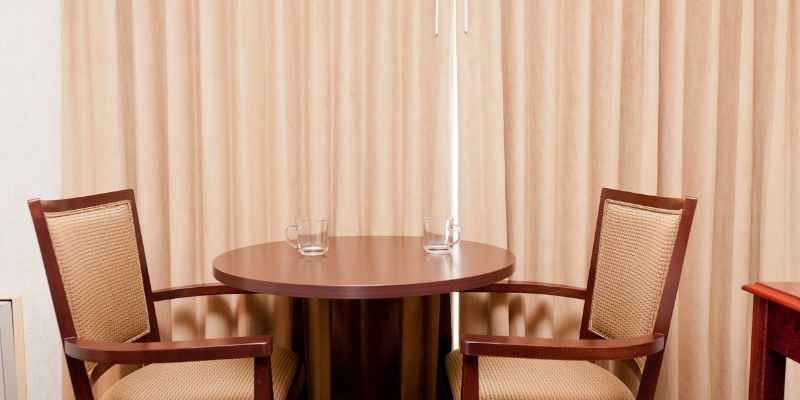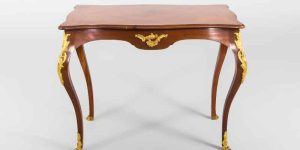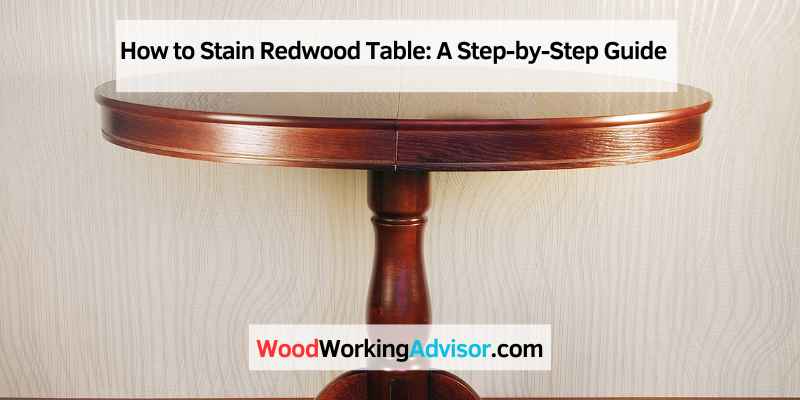To stain a redwood table, sand the surface, apply wood conditioner, then apply the chosen stain. Staining a redwood table can enhance its natural beauty while providing protection against wear and tear.
Redwood is a popular choice for outdoor furniture due to its durability and resistance to decay, but staining can further prolong its lifespan. Whether you prefer a natural or a darker finish, following the correct staining process will ensure a stunning and long-lasting result.
In this blog post, we will guide you through the steps to stain your redwood table effectively, allowing you to enjoy its beauty for years to come.
Introduction To Redwood Furniture
Discover the art of staining a redwood table and enhancing its natural beauty. Follow this step-by-step guide to achieve stunning results that will transform your furniture into a focal point of your space.
The Charm Of Redwood
Redwood furniture is a popular choice for both indoor and outdoor settings due to its natural beauty and durability. The warm, reddish-brown hue of redwood adds a touch of elegance and sophistication to any space. Redwood is also resistant to decay, insect damage, and warping, making it an ideal choice for furniture that will last for years to come.
Benefits Of Staining
Staining your redwood table not only enhances its natural beauty but also protects it from the elements. Staining provides a layer of protection against moisture, UV rays, and other environmental factors that can damage the wood over time. Additionally, staining allows you to customize the color of your redwood table to match your decor and personal style.
When it comes to staining redwood furniture, there are a few things to keep in mind. First, make sure the wood is clean and dry before applying the stain. Sanding the wood beforehand can also help the stain penetrate more evenly. Second, choose a high-quality stain that is specifically designed for redwood or other softwoods. Finally, be sure to apply the stain in a well-ventilated area and follow the manufacturer’s instructions for drying and curing times.
In conclusion, staining your redwood table is a simple and effective way to protect and enhance its natural beauty. By following these tips and using high-quality products, you can ensure that your redwood furniture will continue to be a charming and functional addition to your home for years to come.
Tools And Materials Needed
To stain a redwood table, you will need the following tools and materials: sandpaper, wood stain, paintbrushes, protective gloves, and a clean cloth. Sand the table to prepare the surface, apply the stain evenly with a brush, and wipe off any excess with the cloth.
Protect your hands with gloves throughout the process.
Staining a redwood table is a great way to enhance its natural beauty while also protecting it from the elements. To get started, you will need a few essential tools and materials. Here are the ones you’ll need:
Choosing the Right Stain
The type of stain you choose will depend on the look you are going for and the level of protection you want to provide. There are two main types of stains: oil-based and water-based. Oil-based stains penetrate deeper into the wood, providing better protection, while water-based stains dry faster and are easier to clean up. When selecting a stain, consider the color, transparency, and sheen you want to achieve.
Essential Application Tools
To apply the stain, you will need a few essential tools, including a paintbrush, a rag, and a paint tray. A high-quality paintbrush will ensure even coverage and help you reach tight corners and edges. A rag is useful for wiping away excess stain and blending the color. A paint tray will keep your work area clean and organized and make it easier to apply the stain evenly.
Here’s a table outlining the tools and materials you’ll need to stain your redwood table:
| Tools and Materials | Description |
| — | — |
| Stain | Oil-based or water-based |
| Paintbrush | High-quality for even coverage |
| Rag | For wiping away excess stain and blending color |
| Paint Tray | For keeping work area clean and organized |
Now that you know the essential tools and materials needed for staining your redwood table, you can confidently move on to the next step of the process. With the right tools and a little bit of patience, you can create a beautiful and long-lasting finish on your redwood table.
Preparation Is Key
Preparation is key when it comes to staining a redwood table. Before you begin, make sure the surface is clean, dry, and free of any debris. Sand the surface lightly and apply a wood conditioner to ensure an even stain application.
Then, apply the stain in thin coats and allow each coat to dry fully before adding another.
Cleaning The Surface
Before staining your redwood table, it’s crucial to clean the surface thoroughly. This step ensures that the stain adheres properly and provides long-lasting results. Start by removing any loose dirt, debris, or old finishes from the table’s surface. You can use a stiff brush or a pressure washer to effectively clean the wood.
Next, create a cleaning solution by mixing warm water with a mild detergent. Apply the solution to the table using a sponge or a soft brush, and scrub gently to remove any stains or grime. Rinse the table thoroughly with clean water to remove all traces of the cleaning solution.
Allow the table to dry completely before moving on to the next step. This is important to prevent any moisture from interfering with the staining process. You can speed up the drying process by placing the table in a well-ventilated area or using a fan.
Sanding For Perfection
Once the table is clean and dry, the next step is to sand the surface. Sanding not only smoothens the wood but also helps the stain to penetrate evenly, resulting in a flawless finish. Begin by using a coarse-grit sandpaper (around 80-100 grit) to remove any rough spots, imperfections, or previous stain layers.
After the initial sanding, switch to a finer-grit sandpaper (around 120-150 grit) to achieve a smoother surface. Sand in the direction of the wood grain, applying even pressure. Be sure to sand all areas of the table, including the edges and corners, to ensure uniformity.
Once you’ve completed sanding, use a clean, dry cloth to remove any dust or debris from the surface. This step is crucial as any remaining particles can interfere with the staining process and affect the final result.
Remember, proper preparation is key to achieving a beautiful and long-lasting stain on your redwood table. By cleaning the surface thoroughly and sanding for perfection, you’ll create the ideal foundation for a flawless stain application.
Selecting Your Stain
When it comes to staining your redwood table, selecting the right stain is crucial for achieving the desired look and protecting the wood. There are a few factors to consider, such as the type of stain and the color you want to achieve. In this section, we will explore two key aspects of selecting your stain: oil vs. water-based stains and testing stain colors.
Oil Vs. Water-based Stains
Choosing between oil-based and water-based stains is an important decision that will impact the appearance and durability of your redwood table. Let’s take a closer look at the characteristics of each:
| Oil-Based Stains | Water-Based Stains |
|---|---|
|
|
Consider your preferences and the specific requirements of your project when deciding between oil-based and water-based stains. If you want a traditional, rich look with deep color and enhanced wood grain, oil-based stain may be the best choice. On the other hand, if you prefer a quicker drying time, easy cleanup, and a more environmentally friendly option, water-based stain is worth considering.
Testing Stain Colors
Before applying the stain to your entire redwood table, it’s essential to test different stain colors to ensure you achieve the desired result. Follow these steps to test stain colors effectively:
- Cut a small piece of redwood from an inconspicuous area of your table.
- Sand the piece of wood to remove any existing finish or stain.
- Apply a small amount of each stain color you are considering to the sanded wood.
- Allow the stain to dry completely.
- Observe the color in different lighting conditions to see how it looks on the redwood.
- Once you have determined the ideal stain color, proceed with staining the entire table.
By testing stain colors beforehand, you can avoid any surprises and make an informed decision about the final color of your redwood table. Remember to consider the overall aesthetic of your space and how the stain will complement the existing décor.
The Staining Process

When it comes to staining a redwood table, the staining process is crucial for achieving a beautiful and durable finish. Properly applying and wiping off the excess stain can make all the difference in the final look of the table.
Applying The Stain
To start the staining process, prepare the redwood table by sanding it with fine-grit sandpaper to create a smooth surface. Use a clean cloth to remove any dust from the surface. Then, apply the redwood stain evenly with a brush or cloth, following the wood grain. Allow the stain to penetrate the wood for 5-15 minutes, depending on the desired color intensity.
Wiping Off Excess
After allowing the stain to penetrate, wipe off the excess with a clean, dry cloth. It’s important to wipe in the direction of the wood grain to avoid streaks or uneven coloration. Take care to remove all excess stain to prevent tackiness or uneven drying. Let the stained table dry completely before applying a protective finish.
Drying And Curing Time
To stain a redwood table, it is important to consider the drying and curing time of the stain. After applying the stain, allow it to dry completely before adding additional coats. It is recommended to wait at least 24-48 hours before applying a sealant or topcoat to ensure proper curing.
Ideal Conditions For Drying
In a well-ventilated area, redwood table needs dry, warm conditions.
Ensure humidity levels are low and temperatures are consistent.
Patience Is A Virtue
Allow the stain to dry for 24 hours before using the table.
Full curing may take up to two weeks, so be patient.
Adding Extra Protection
When staining a redwood table, adding extra protection is crucial to ensure longevity.
Sealants For Durability
Choose high-quality sealants to enhance the table’s durability.
Uv Protection For Redwood
UV protection prevents fading and damage from sunlight exposure.
Maintenance Tips
To maintain a redwood table, start by preparing the surface and choosing a high-quality stain suitable for outdoor use. Apply the stain evenly using a brush or cloth, following the wood grain for a smooth finish. Allow the stain to dry completely before adding a protective sealant to keep the table looking vibrant and protected from the elements.
Regularly clean the table and reapply the sealant as needed to preserve its beauty.
Regular Cleaning
Wipe the table with a damp cloth. Avoid harsh chemicals to prevent damage.
Reapplying Stain Over Time
Inspect the table for faded areas and reapply stain as needed.
Troubleshooting Common Issues
To troubleshoot common issues while staining a redwood table, ensure proper sanding for an even finish. Use a high-quality wood stain and apply thin, even coats to prevent blotching. Allow sufficient drying time between coats for a professional-looking result.
Stain Bubbles And Blotches
If bubbles or blotches appear, sand the table lightly.
Fixing Uneven Coats
Apply more stain to lighter areas for an even finish.
Final Touches
After applying the stain to your redwood table, the final touches are crucial to ensure a professional finish. From inspecting your work to enjoying the beauty of your newly stained redwood table, these final steps will complete the process and enhance the overall appearance and durability of your table.
Inspecting Your Work
Take a close look at the stained redwood table to ensure that the application is even and free of any drips or streaks. Check for any areas that may need touch-ups and address them promptly to achieve a flawless finish. Wipe off any excess stain to prevent drips and smudges, and ensure that the entire surface is uniform in color and appearance.
Enjoying Your Redwood Table
- Allow the stained redwood table to dry completely according to the manufacturer’s instructions before using it.
- Once dry, place it in your desired location and take a moment to appreciate the natural beauty of the redwood grain enhanced by the rich stain.
- Consider applying a protective finish or sealant to further safeguard the table from daily wear and tear, ensuring that it remains a stunning centerpiece for years to come.

Frequently Asked Questions
How Do I Prepare Redwood For Staining?
To prepare redwood for staining, start by sanding the surface to remove any existing finish and ensure a smooth texture. Clean the wood to remove dust and debris, then apply a wood conditioner to promote even staining. Finally, test the stain on a small area before applying it to the entire table.
What Type Of Stain Is Best For Redwood?
For redwood, a penetrating oil-based stain is often recommended as it enhances the natural beauty of the wood while providing protection. Look for a high-quality, UV-resistant stain that is suitable for exterior use and offers long-lasting durability.
Can I Stain Over Existing Redwood Stain?
Yes, it’s possible to stain over existing redwood stain as long as the previous stain is in good condition and the surface is properly prepared. Ensure the old stain is clean, dry, and free of any peeling or flaking. Consider applying a test patch to assess compatibility and desired color.
Conclusion
In wrapping up, staining a redwood table enhances its beauty and durability. By following the right steps and using quality products, you can achieve professional results. Remember to prep the wood properly, apply the stain evenly, and protect your work with a sealant for long-lasting beauty.
Happy staining!

